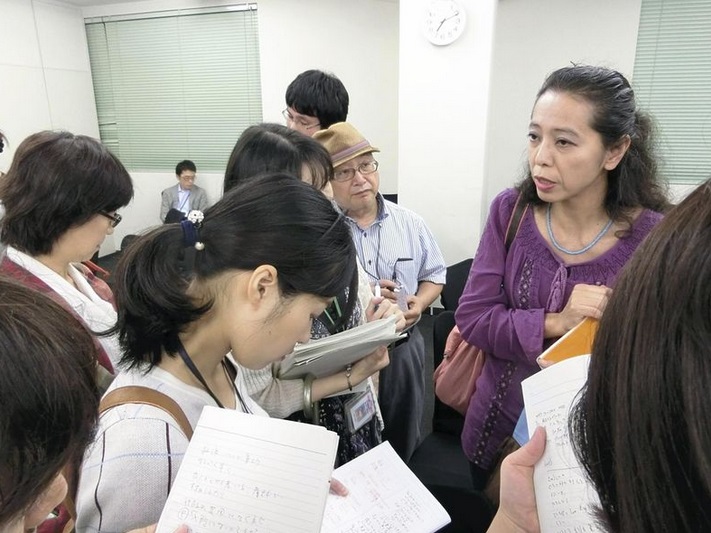
Behind the Scenes / Cancer vaccine reactions stand out in Japan
http://the-japan-news.com/news/article/0002445985

The Yomiuri Shimbun
The mother of a victim, right, speaks to reporters that she can “appreciate” the government’s decision to maintain its suspension of the government-supported cervical cancer vaccinations.
September 27, 2015
By Ryota Akatsu and Atsuko Kinoshita / Yomiuri Shimbun Staff Writers
Responding to reports of severe symptoms following cervical cancer vaccinations, the Health, Labor and Welfare Ministry has checked on all recipients who experienced issues. It announced on Sept. 17 that 186 individuals had still not recovered. These vaccines are in use around the world, so why are Japanese patients affected so severely by them?
Hindrance to school life
Cervical cancer vaccines (see below) were incorporated into routine vaccination procedures under the Preventive Vaccination Law in April 2013, but reports of chronic body pain following vaccinations prompted the temporary suspension of vaccinations in June that year.
In August 2014, Norihisa Tamura, then health, labor and welfare minister, promised to assess the conditions of all patients who had reported problems, and a survey of 2,600 recipients was carried out.
The survey found that of the 1,739 patients who reported symptoms, the vast majority recovered within one week, but 186 patients had not yet recovered. The symptoms were wide-ranging, including headaches, body pain and convulsions, and over 60 percent of sufferers experienced multiple symptoms. Middle and high school-aged girls were the most affected, hindering their ability to attend classes and hugely impacting their school lives.
Based on the findings of an investigative committee — chaired by Mariko Momoi, vice president of the International University of Health and Welfare — and commencing on the same day they were released, the ministry began urgently studying how to bring relief to patients suffering symptoms, and established a plan for a student support consultation network.
Some obstetricians and gynecologists seeking to prevent cervical cancer called for vaccinations to resume, but Momoi refused, saying, “In order to provide citizens with relevant information, investigations must continue.”
Perceptions of vaccines vary
Of the roughly 120 countries using these vaccines, only Japan changed its practices following reports of adverse reactions. The World Health Organization has made repeated appeals for a calm approach to the situation, stating it has not found any cause for concern.
Even abroad, there have been reports of acute body pain following inoculation. But while Japan has found that 1.1 cases in 100,000 vaccinations suffer from acute body pain, the United States and South Korea report only 0.1 cases per 100,000 vaccinations and Britain reports 0.6 cases per 100,000, which include minor adverse reactions. As criteria vary from country to country, comparisons are difficult. Despite this, Japan’s numbers are high.
While racial differences have been suggested as a possible cause, it also has been suggested that as “this has become an issue of public concern, the vigilance of doctors” has also contributed to more rigorous diagnoses. The opinions of specialists are divided.
The ministry plans to hold discussions with the investigative committee regarding reinstating use of the vaccines, but only after completion of investigations into the causes of the symptoms and the prevalence of symptoms in patients regardless of their vaccination status.
Routine vaccination procedures under the law are endorsed by the government, and individuals are required to be vaccinated. The cervical cancer vaccines are still included in the routine vaccination program and are available upon request. However, they are not actively recommended, and — unlike other vaccinations — leaves the decision of whether or not to be vaccinated up to the individual. The government owes the people a satisfactory explanation.
Relief measures under review
The government will offer relief measures to those who suffer as a result of vaccinations, but, in reality, investigations into cervical cancer vaccines have been put on hold until the follow-up survey of patients has been completed. Procedures for relief measures will be based on the results of the survey.
Cervical cancer vaccines were integrated into the government’s routine vaccination program in April 2013. Prior to this, however, the government began a subsidy program for the vaccines and promoted them widely.
During this period, the vaccination had been considered an “optional vaccination,” with the independent administrative institution of the Pharmaceuticals and Medical Devices Agency (PMDA) as the point of contact for any reports of problems. For the routine vaccination program, problems are handled by municipal government.
If the relationship between the vaccines and symptoms cannot be disproved by the current investigation, both groups will reimburse those afflicted with the cost of out-of-pocket medical expenses, as well as a medical treatment allowance (up to ¥30,000 a month). However, while those who were part of the routine vaccination will be reimbursed for both inpatient and outpatient treatment, those who were part of the “optional vaccination” only will be reimbursed for inpatient treatment.
As the government was involved in both phases of treatment, the Health, Labor and Welfare Ministry intends to eventually do away with the differences between the two reimbursement schemes.
There have been 15 applications for aid from patients who took part in the routine vaccination as of the end of July 2015. The ministry began certification work on the Sept. 18, based on the assumption that the results of the follow-up survey will provide a complete picture of the situation. Of the 98 applications received from patients who took part in the optional vaccination, only about 30 have been processed for compensation. Attempts are under way to expedite the process.
■ Cervical cancer vaccines
Vaccines currently available are Cervarix, which went on sale in December 2009, and Gardasil, which went on sale in August 2011. These vaccines are meant to protect against two types of viruses, which are said to be the cause of 50 percent to 70 percent of cervical cancer cases.Speech